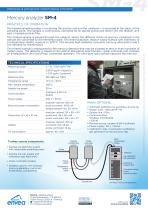 Website:
ENVEA
Website:
ENVEA
Catalog excerpts

Continuous Mercury Emissions Monitoring PROCESS & EMISSIONS MONITORING SYSTEMS With more than 20 years of experience as a bespoke solutions provider in various applications, Mercury Instruments has distinguished itself by developing the first mercury emissions monitoring system using the dry thermocatalytical method. It is now possible to avoid the use of chemical reagents and thus optimize operating costs and measurement availability. The continuous mercury analyzer SM-4 allows the compliance with future measurement obligations (Minamata convention & the European directives for thermal power plants and incinerators). Designed for accurate and reliable measurement of very low mercury concentrations in flue gases within complex matrices (SO2, NOx, HCl, etc.) SPECIFIC FEATURES: S ampling line length up to 100 m (300 ft) N o liquid waste or condensate generated E xtremely high precision measurement A utomatic back-flush function C ontinuous measurement of total Hg (elementary, ionic & organic) S ample dilution directly at sampling point, allowing large measuring range & elimination of interferences from matrix gases S ampling system – composed of the probe, the dilution unit and the low temperature catalytic converter – is entirely heated to avoid mercury adsorption Sampling unit directly on stack: maintenance-free & no transport of ionic Hg O ption to install elemental Hg calibration gas generator, NIST traceable, inside analyzer cabinet V ery low maintenance (service interval: ≥ 3 months) – can be automated SM-4 Mobile (option) MAIN APPLICATIONS: Coal fired power plants (before & after mercury absorbers) Cement kilns Sulfuric acid producing foundries Incineration plants (industrial, medical waste, sewage sludge...) Thermal treatment of contaminated soils, hazardous waste M etallurgical facilities with potential Hg emissions... COMPLIANCE WITH IED, WID & LCPD APPLICATIONS
Open the catalog to page 1
PROCESS & EMISSIONS MONITORING SYSTEMS PRINCIPLE OF OPERATION: The heated sampling probe — containing the dilution unit and the catalyzer — is mounted at the stack, at the sampling point. The sample is continuously extracted by an ejector pump and drawn into the dilution unit, past a heated particle filter. The treated sample is transported to the mercury detector that may be situated at tens or even hundreds of meters away. The detector is based on the atomic absorption spectrometry (AAS) principle, and contains an amalgamation unit (GoldTrap) connected upstream. The ultra-pure gold...
Open the catalog to page 2All ENVEA catalogs and technical brochures
-
LAS 5000XD
2 Pages
-
Amesa-M Mercury Sampler (Hg)
2 Pages
-
PCME STACK 980
4 Pages
-
PCME STACK 602
4 Pages
-
PCME STACK 710 dust monitor
4 Pages
-
PCME STACK 990
4 Pages
-
MGC101- Multi-Gas Calibrator
2 Pages
-
E-Series - AF22E SO2 monitor
2 Pages







































































